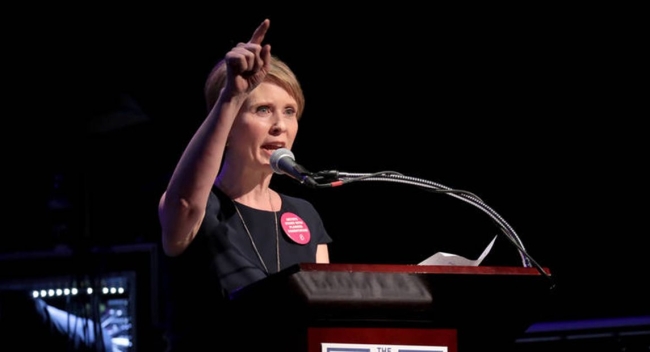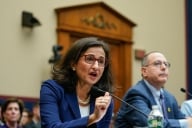You have /5 articles left.
Sign up for a free account or log in.

Cynthia Nixon
Courtesy Cynthia for New York
A New York primary election that has laid bare tensions between different wings of the Democratic Party has also exposed debates within the free college movement and advocates focused on degree completion.
Cynthia Nixon, who is attempting to mount a left-wing primary challenge to two-term incumbent governor Andrew Cuomo, last week rolled out an education plan proposing significant changes affecting Cuomo’s signature higher ed accomplishment, the free public college tuition program known as the Excelsior Scholarship. Compared to Excelsior, Nixon’s plan would focus on a group of students from lower-income backgrounds who may not advance as quickly toward graduation.
The Excelsior Scholarship was designed with several restrictions “to exclude students in order to reduce program costs,” Nixon’s plan argues. Excelsior generally requires students to complete 30 credits per year and earn an associate degree in two years or a bachelor’s degree in four years. It requires recipients to live and work in New York after college for the same number of years they received scholarships or have their scholarships convert into loans. And it is structured as a last-dollar program, paying tuition costs after other sources of funding, like the federal Pell Grant or New York’s Tuition Assistance Program, have been taken into account.
Nixon calls for a requirement that students earn 24 credits per academic year, not 30. She would count remedial courses toward the credit requirement, something the Excelsior Scholarship does not do. Plus, she would do away with residency requirements and says she backs a first-dollar program that would free Pell Grants for other expenses like housing and books.
“Providing a first dollar program is very important if New York is going to be serious about expanding access to higher education and seeing larger numbers of low income students, students of color and immigrant students graduate from college,” Nixon’s plan says.
Her plan also calls for making college free for all students who would qualify for New York’s existing Tuition Assistance Program, which has a family income limit of $80,000. It’s a substantially lower income cutoff than Excelsior, which is being phased in over three years. Excelsior covered students from families with annual incomes of up to $100,000 in its first year. It will cover families making $110,000 starting this fall and $125,000 in the fall of 2019 and afterward.
Nixon's proposed changes would open up free tuition to 170,000 new students at the State University of New York and City University of New York systems, the Nixon campaign estimates. It would cost $600 million per year.
Nixon’s education plan would pair the free tuition changes with spending to support graduation and additional funding for SUNY and CUNY. The total price tag for the higher ed initiatives would be more than $1.6 billion. Nixon proposes funding her plan and other new education spending with a tax package that would increase taxes on corporations and New Yorkers earning more than $300,000.
Cuomo’s camp maintains that the state’s existing Tuition Assistance Program already accomplishes many of the goals laid out in Nixon’s plan. TAP is a first-dollar program requiring students to take 12 credits toward a degree program per semester. TAP and other programs mean New York supports its at-risk and poorest college students, Cuomo’s allies argue.
About 45,000 students have received free tuition after applying for the Excelsior Scholarship, they said. Roughly 23,000 received Excelsior funding, and 22,000 applied for Excelsior but were steered into TAP, where they received free tuition.
A spokeswoman in the governor’s office called Nixon “wrong on the facts on every issue she discusses.” The Nixon campaign responded that TAP provides full tuition funding for only a small percentage of recipients and that Nixon wants to expand program access to immigrants. In 2016-17, the average TAP recipient received $3,320 from the program, according to the state Higher Education Services Corporation.
Meanwhile, a group representing New York’s private colleges and universities is unhappy with Nixon’s higher ed plans.
“It is unfortunate that Cynthia Nixon did not do her homework before releasing her plan for education in New York,” said Mary Beth Labate, president of the Commission on Independent Colleges and Universities, in a statement. “Her ‘Educate NY’ plan ignores the 300,000 New Yorkers who choose to pursue higher education at a private, not-for-profit college or university in our state. Two-thirds of those students come from families that earn less than $125,000 annually.”
Nixon’s plan would serve students in private colleges by expanding the Arthur O. Eve Higher Education Opportunity Program, according to a Nixon campaign spokeswoman. The program makes competitive grants to independent institutions for students who are academically and economically disadvantaged.
The back-and-forth between the campaigns shouldn’t obscure the issues Nixon tapped into that are being debated by free-tuition advocates across the country: What restrictions are reasonable to build into programs offering free public college tuition, and which ones can be used to steer students to make desirable choices?
Free-tuition programs -- called Promise programs -- vary significantly in design across the country, said Martha J. Kanter, a former under secretary of education in the Obama administration who is now director of the College Promise Campaign, a group advocating for making the first two years of college free.
Some programs limit enrollment to full-time students who just came from high school and are making progress toward a college degree. Others are focused on meeting workplace needs in high-demand areas for adults who are returning to complete a degree.
“This is an early stage,” Kanter said. “There’s no cookie-cutter state policy, so every state is doing what’s best for their residents.”
New York is a highly visible example of a state where politicians are debating changes to free college programs recently put in place. It’s not the only one. A bipartisan group of lawmakers in Tennessee rejected changes in April that Republican governor Bill Haslam wanted to make to the well-known Tennessee Promise program. Haslam wanted to require aid recipients to finish 30 credits per year or risk losing some of their scholarships. The Tennessee Promise currently has a requirement of 12 credit hours per semester.
Advocates such as Complete College America, which has backed ideas like 15 to Finish, say completing 15 credits a semester, or 30 credits per year, keeps students on track to graduate on time, increasing the likelihood they will complete degrees. Critics retort that strict credit requirements prevent working students or those with family responsibilities from benefiting from free-tuition programs.
“It’s raising an important issue,” Kanter said. “What do we do with people who have work and family responsibilities?”
Excelsior has attempted to thread the needle between the two positions by blending hard-line credit requirements with wiggle room for extenuating circumstances. Although it requires students to complete 30 credits per year, Excelsior’s regulations allow for repayment waivers and postponements for cases of hardship, and they allow students with disabilities to attend college part-time.
It’s far from the only solution. An April report from the College Promise Campaign and two other groups, Complete College America and Achieving the Dream, argued that institutions in promise programs serving part-time students should “provide a structured, part-time pathway that adds no more than one year to the students’ time to degree.” Among its recommendations, it said institutions should provide term-by-term degree or certificate maps with 20 to 24 credits per calendar year for students who are unable to attend full-time. Doing so would promote graduation within a year of a program’s published length, it said.
Nixon’s plan is also notable because it contains provisions likely to upset middle-income voters. An $80,000 income limit would mean some families who expected to qualify for free tuition under Cuomo’s program will in fact not be able to have their children attend college for free. Eliminating residency requirements may be popular with students who want to keep their postcollege options open, but it might not sit well with some voters who wonder why the state should pay to educate another state’s employees.
“These residency requirements are politically popular within states,” said Robert Kelchen, assistant professor in the department of education leadership, management and policy at Seton Hall University. Eliminating the requirements makes sense from a broad public policy perspective more than it makes sense from the perspective of a politician running for election, he added.
Nixon’s emphasis on a first-dollar program is unusual because first-dollar programs are expensive, Kelchen said.
“If a state wants to reduce student debt, it’s the way to go, but does this program really get more students into college?” Kelchen asked. “The price tag is fairly large, and I’d be curious what people think about whether that price tag is realistic.”
Time will tell whether Nixon’s education plans do anything to shake up a race that has not been competitive. Nixon trails Cuomo among Democrats by 35 points, 61 percent to 26 percent, according to a Siena College poll of likely voters that was released the same day as Nixon’s education plan.
The challenger’s strategy has been to run to the left of Cuomo, and her higher ed plans are largely consistent with that positioning. But it’s not clear the changes she proposes have widespread appeal even within the primary electorate.
“Suburban Democrats, they supported the governor’s Excelsior program,” said Steven Greenberg, a Siena College pollster. “A lot of suburban kids who are defined more as middle-class than poor have taken advantage of that benefit. So while it certainly plays to one audience, I’m not sure that it plays to all the audiences that are going to participate in the Democratic primary.”
Candidates’ proposals can linger even if they don’t win election, of course. Bernie Sanders’s backing gave the free college movement oxygen, even though the Vermont senator did not capture the Democratic presidential nomination in 2016. In fact, Sanders was present when Cuomo unveiled his free college plans in 2017.
Still, those who watch New York politics aren’t expecting Nixon’s education plans to shake up the race.
“I’d be very surprised if that cut through the clutter,” Greenberg said of the plan.








